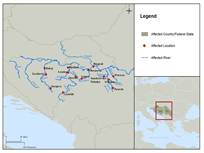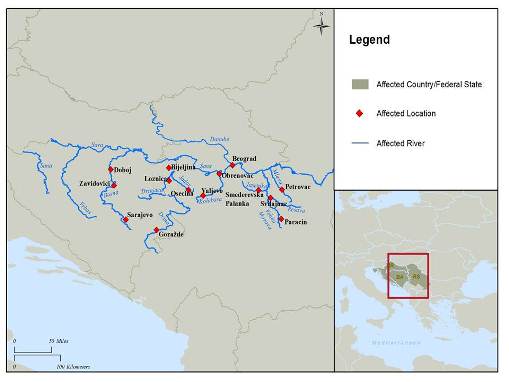

Event Summary
Heavy rain has caused widespread flooding across several countries in the Balkans region of Southeast Europe. Serbia, Bosnia and Herzegovina and Croatia were badly affected by the floods in May. According to Serbia's Meteorological Institute, three months' worth of rain fell in just three days in mid-May, resulting in the worst floods to hit the country since rainfall measurements began some 120 years ago. Bosnia also experienced its heaviest rainfall since records began in 1894, reports said.
A number of rivers burst their banks as a result of the heavy rainfall, flooding thousands of homes and forcing tens of thousands of people to evacuate their properties. States of emergency were declared in Serbia, Bosnia and Croatia. At least 60 people have died as a result of the floods across the region and hundreds of landslides have cut off communities with a number of roads and railways lines blocked. There are also concerns the floods may have exposed unexploded landmines from the civil war in Bosnia during the 1990s.
Hazard data illustrated in the CAT-i map was taken from i-aXs®, Guy Carpenter’s web-based risk management platform. i-aXs users can view impacted areas on any map as well as see how their portfolios were affected. Please contact your broker or GC Analytics® representative for assistance or go to www.i-axs.info for further information.
The economic impact of the floods is likely to be significant, not only destroying tens of thousands of homes but also devastating agricultural interests vital to both the Serbian and Bosnian economies. Indeed, the European Bank for Reconstruction and Development (EBRD) has estimated that the damage bill from the floods in Serbia and Bosnia alone could exceed EUR3 billion, with the cost of the damage in Serbia estimated to be between EUR1.5 billion and EUR2 billion and approximately EUR1.3 billion in Bosnia.
The EBRD said the estimated cost of damage was "very rough." More definite damage estimates are expected within the next week or two. Although it remains too early to estimate what impact the event will have on the (re)insurance sector, insurance penetration in Serbia and Bosnia and Herzegovina is relatively low.
Damage Assessment
Reports said up to 300mm of rain fell in some parts of Serbia and Bosnia in 48 hours. Western and central Serbia and northern and eastern Bosnia suffered the worst damage from the floods. Around 1.6 million people are thought to have been affected by the floods in Serbia and Bosnia alone. Widespread property damage has been reported, with tens of thousands of homes inundated and businesses across both countries facing prolonged disruption. Damage to the Serbian energy sector is also likely to be costly after power plants were flooded.
The floods also caused significant damage to the agriculture sector, which provides 10 percent of Serbia's GDP and 6 percent of Bosnia's GDP, according to the EBRD. Most of the arable land in flooded areas has been destroyed and the agricultural damage in both countries could run into the hundreds of millions of euros, the EBRD said. In addition, roads, railways, water supply and energy infrastructure were also badly hit. Although the floodwaters are now receding across the region, vast areas still remain under water and tens of thousands of people remain in shelters, unable to return home.
Serbia
Severe and widespread flooding badly hit western and central regions of Serbia, prompting the country's prime minister to describe the event as "the worst natural catastrophe that has ever hit Serbia." The Sava River rose to its highest level on record during the height of the floods, prompting nearby communities to evacuate their homes. Reports said the worst affected community was Obrenovac (with a population of around 20,000 people) after 90 percent of the town was flooded by the overflowing Kolubara River. Overflowing rivers also inundated a number of towns and cities in Serbia, including Paraćin, Valjevo, Osecina, Loznica, Petrovac na Mlavi, Svilajnac and Smederevska Palanka. At least 25,000 people were evacuated across the country. Although some minor flooding occurred in the capital of Belgrade, the city escaped significant damage.
Severe agricultural damage has been reported across Serbia, with crops and animals perishing in the floods. Industrial facilities were also affected by the floods. Reports said more than 2,000 public, industrial and infrastructure facilities were flooded in total. Around 300,000 households lost power after two power plants were partially shut down because of rising floodwaters. Serbia's largest power plant, Nikola Tesla, which supplies around half of Serbia's electricity, was spared significant damage and disruption, although a unit at the facility was shut down because of rising floodwaters. The floods caused considerable damage (estimated by the government at over EUR100 million) to the Kolubara coal mine that supplies Nikola Tesla.
Widespread infrastructure damage has also been reported across Serbia after floods and landslides damaged roads, bridges and railway lines. According to reports, 3,500 roads were destroyed and nearly 1,800 have been put at risk.
Bosnia
In Bosnia and Herzegovina, more than a quarter of the country's four million people were affected by the floods, with the Bosna river valley in central Bosnia worst affected. Several rivers overflowed across the country, including the Sana, Sava, Vrbas and Drina. A number of towns and cities were inundated, including the capital of Sarajevo (where the Miljacka River swelled almost to the level of city bridges) and the cities of Gorazde and Bijeljina. The Bosna River also flooded the towns of Doboj, Maglaj, Zavidovici and Samac, according to reports.
Government officials estimated that more than 100,000 buildings in Bosnia were inundated in total and over a million people have been cut off from clean water supplies. At least 500,000 people are thought to have evacuated their homes. The flooding also caused significant damage to infrastructure and agricultural interests across the country. Government figures estimate that up to 3,500km of roads have been damaged or destroyed and 30 percent of the country's railway lines are unusable as a result of the flooding.
There is also concern that the floodwaters might expose landmines left over from the Bosnian War. There have been some reports of landmines surfacing as the floodwaters recede, highlighting the dangers that remain.
Croatia
Croatian regions that border Serbia and Bosnia were also affected by the flooding. More than 15,000 people were reportedly evacuated from their homes in eastern Croatia. Two people were reportedly killed by the floods in Croatia.
Insured Loss Information
It still remains too early to draw any definitive estimates of insured losses from the floods in the Balkans. However, Milan Simic, managing director at AIR Worldwide, has been quoted by Insurance Day as saying that a 100-year return period loss in Serbia would total EUR1.5 billion, assuming all building stock was insured. He added that this event will incur a relatively small proportion of this total, "probably a single-digit percentage."
Sources: Reuters News, BBC News, Agence France Presse, Associated Press, Insurance Day, European Bank for Reconstruction and Development
Guy Carpenter publishes CAT-i reports for major natural catastrophes worldwide. These reports cover catastrophes including worldwide tropical cyclones, earthquakes, major UK and European floods and any other natural event that is likely to incur a significant loss to the (re)insurance industry. Please email mailto:CAT.i@guycarp.com if you wish to be added to the free email distribution list.
Guy Carpenter compiles RISK-i reports for major technological or man-made events worldwide. These reports cover risks to property, transport and life including explosions, fires, crashes, engineering disasters and terrorist attacks that are likely to incur a significant loss to the (re)insurance industry. Please email RISK.i@guycarp.com if you wish to be added to the free email distribution list.